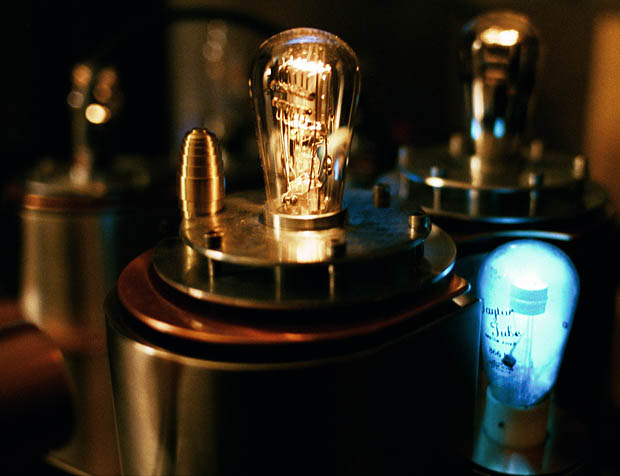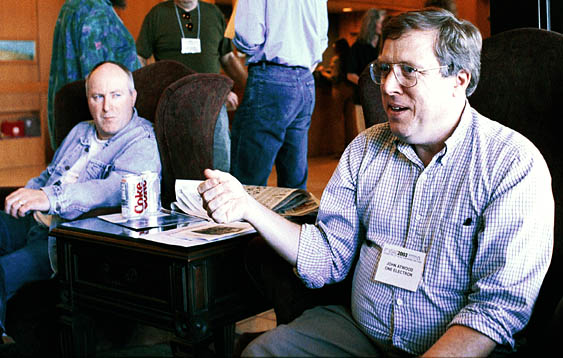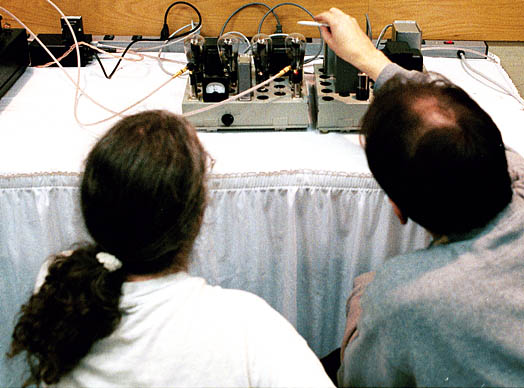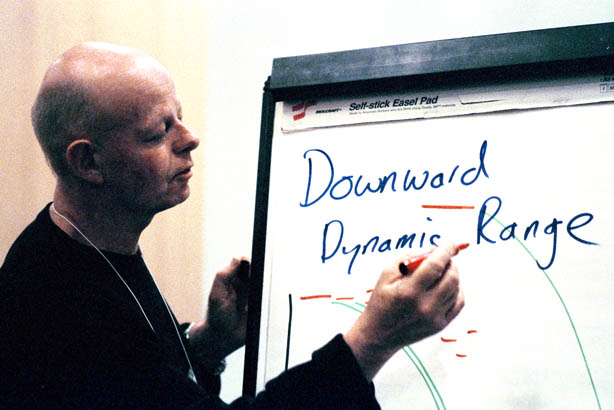
Josh Stippich hits the Big Time with the Electronluv 801/2A3 amplifier.
Vacuum Tube Valley VSAC 2003 Show Report
by Lynn Olson

Unlike the CES, which is a marketing-driven trade show for hifi dealers, the VSAC, originated and organized by Dan Schmalle (aka Doc Bottlehead), is a show for vacuum-tube enthusiasts. People who start off in the Craftsman's Room frequently "go professional", like Josh Stippich, and have their own demo rooms two years later. But going pro, at the VSAC, doesn't mean replacing engineers and designers with marketers. Not at all. The 2003 show attracted manufacturers, engineers, designers, and enthusiasts from all over the world.
You've probably already seen the show reports from Positive Feedback Online and SixMoons.com. These are reports written from a consumer perspective; what's hot, what's not, lots of photos, what the audio-reviewer liked best. They also cover the entire show, room by room, giving a virtual tour of the show.
What you'll see here is a personal impression of the 2003 VSAC show. You'll travel along with me as I chat with the designers; I spent little time listening, mostly schmoozing and taking photos. I know from hard experience (as a CES exhibitor) good sound at a hotel-based show is more a matter of dumb luck than anything else. Sometime you roll the dice, it sounds good, sometimes not, and sound that changes from hour to hour isn't unusual in small hotel rooms with just-barely-adequate power.
I remember one year at the Sahara Bi-Level in Las Vegas when the power was so unreliable that the show organizers had to rent a collection of construction-sized generators, park them in the parking lot, and run 1" thick power cables through partially open windows into the rooms. You can imagine the appalling effect on the sound of equipment. I think that was the year I wandered away from the high-end ruckus and discovered that the Adult-Video part of the CES had moved to the other side of the Sahara hotel.
(Hey, you think that was bad, the previous year the porno dudes shared the same hallways as the high-end CES crowd. Their rooms were one side, we were on the other. No joke man, I was there. This wasn't just weird, it was downright freaky. Imagine hundreds of Italian-suit marketing flacks, nerdy engineers, Stereophile reviewers, guys with slicked-back hair dressed in New Jersey leisure suits smoking cigars, and well-endowed Las Vegas showgirls all jammed in the same hallways. Now that was a memorable CES.)
Well, no Vegas showgirls here, you'll have to go elsewhere on the Internet for that. What follows is my personal experience of the VSAC - the Valhalla for the outer limits of the audio world, vacuum-tube engineers, designers, and hard-core enthusiasts.

On Friday, first day of the show, there was a mini-conference about transformers in progress in the lobby of the hotel, with Tom Hodgson (published in Sound Practices #4), John Atwood (former Tech Editor of Vacuum Tube Valley, now head of One Electron), and Bud Purvine (transformer designer for O-Netics in Everett, Washington). The high-energy discussion drew in several other audio enthusiasts, including Ben Reginato, head of the Bay Area Tube Enthusiasts.

I can't think of any hifi show in the world where three world-class transformer engineers would be meeting in the lobby - on the first day! I felt privileged to be there, and listen in on the discussion. Not everyone agreed - indeed, there was spirited disagreement at times - but the process of disagreement was illuminating for this listener, revealing the life experiences, technique, and way of thinking of all three designers. I'd say it was a safe guess that I heard 50 to 70 years of engineering experience in that meeting alone.

Gary Pimms's unusual PP47 amplifier has gotten a lot of notice in the Tube DIY Asylum recently; especially since the operation of the circuit isn't at all obvious from the schematic. Unlike the prevailing SET all-triode trend, this is an all-pentode all-differential design that exploits the low capacitance and high speed of pentode circuitry.
In fact, if the 47 pentodes are connected as triodes, or in an ultralinear connection, the advantages of the circuit disappear. It relies on the local-feedback resistors around the 47 output tubes to set the gain of the 6AU6 pentodes in the input section, which in turn are only lightly loaded by the very small capacitance of the output section. Gary's amplifier is not in the all-triode, all-SET mainstream of past VSAC shows.

Allen Wright (of Vacuum State Electronics) started his talk with a discussion of "Downward Dynamic Range", which he defined as the ability to retain detail in the presence of higher-level signals. Some amplifiers can't render low-level detail at all, and many others do fine so long as there are no other competing transients. What's difficult is retaining subtle tonal qualities, along with hall ambience, while the rest of amplifier has powerful swings in the power-supply current.
This requires fast-recovery low-noise power supplies, as well as linear circuits that aren't easily perturbed by fast-moving transients. Allen has long favored oscilloscope-style all-differential circuits with current sources on the cathodes, using it in his Real-Time preamps that are discussed in his "Preamp Cookbook."

Allen has now applied the same principles to a power amplifier; this picture shows the first disclosure of Allen's circuit. The addition of a current source to the power tube's cathode converts a conventional PP amplifier to an all-differential, all-Class A amplifier. In fact, the current source actually prevents the circuit from entering into Class AB. If excessive current is demanded, the amp clips, just like a SE amplifier. As a result, the current drawn from the power supply is almost constant, and the high degree of balance rejects nearly all power-supply noise.
In addition, just as in a low-level circuit, the current source compensates for variations in gain-matching between the pair of tubes, so the overall circuit gain is always precisely the gain of A+B/2. Although the current source looks like a minor addition, it actually converts a parallel amplifier (conventional PP) into a series amplifier - the output tubes are effectively connected in series with each other, like a string of Christmas-tree lights.
How does the VSE DPA-300B sound? After the show, I had Allen as a guest at my home here in Silverdale, and listened to the amplifier on my Ariel speakers. The VSE DPA-300B is very transparent and "direct" sounding, and quite different from most SE or PP amplifiers. It actually has a sonic kinship with Gary Pimm's PP47 amplifier, and this isn't surprising, since both share some circuit features, and Allen and Gary were independently working on a common track over the last several months. VSAC 2003 was a "coming-out party" for both amplifiers, and a place for the world to hear for the first time designs that were discussed on the audio-design forums on the Internet.
Page Two
All Text and Photographs © 2003 Lynn Olson.